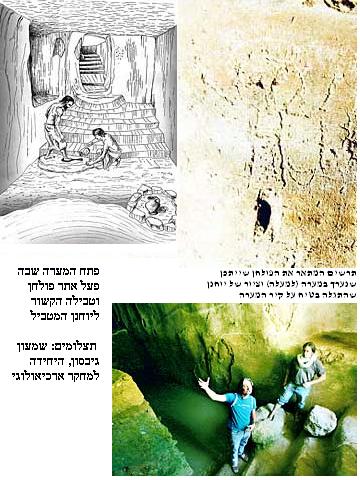Mysterious wall paintings discovered in a cave south of Jerusalem, led to a discovery possibly related to John the Baptist.
Amiram Barkat, Haaretz, Walla

Mysterious wall paintings discovered in a cave south of Jerusalem, led to a discovery possibly related to John the Baptist. The discoveries in the cave indicate, according to the researchers, that the earliest baptismal site discovered so far was located there, and at a site that has great significance regarding the beginning of Christianity. "The place we uncovered is probably the link that connects Jewish and Christian baptism," claims Dr. Shimon Gibson, the archaeologist who led the excavation.
In 1999, members of Kibbutz Zova led Dr. Gibson to a cave they used to visit from time to time. Gibson, who conducted an archaeological-environmental survey in the area, decided to measure the cave, and to his surprise, while removing stones from the cave's entrance, paintings carved into the plaster on the cave's walls were revealed.
The paintings, which date to the fourth or fifth century AD, include symbols associated with John the Baptist, including his image, his severed head, his hand and the shape of a cross named after him. Yohanan, who baptized Jesus, was born according to Christian tradition in Ein Kerem,
Photo: Shimon Gibson, Archaeo Research Unit
which is not far from the place. In the New Testament it is stated that John died after Herod's son, King Herod Antipas, ordered his head beheaded. According to early Christian texts, the only remnant left of John's body was his hand.
For three years, Gibson and his assistant, archaeologist Rafi Lewis, excavated the cave. Its length is 26 meters, its width is four and a half meters and its average height is five meters. The excavations were conducted under the auspices of the University of North Carolina and funded by the Whitehead Foundation.
According to Gibson, the remains of fireplaces were discovered at the site, at least one of which was used to light incense. The remains are from the fourth and fifth centuries AD - the beginning of the reign of the Byzantine Empire. "According to all the signs, the place was used for seclusion at that time.
It seems that monks would come to the place from Yohanan's monastery in Ein Kerem to isolate themselves, perhaps on special occasions that were related to Yohanan's life." However, later on in the excavations, it became clear to Gibson and Lewis that the Byzantine period was only the "tip of the iceberg" in the history of the use of the cave.
During the excavations, two wide staircases and tens of thousands of fragments of pottery, most of them jugs, were discovered. Archaeological tests have determined that the earliest pottery is from the middle of the second century BC, and the latest from the days of the Bar Kochba revolt, in the second century AD. The great majority of the pottery was from the first century AD.
The most intriguing find discovered in the cave also dates to the first century AD. This is a basin similar to an oil basin, from which a small channel leads into a footprint carved into the rock. According to the archaeologists, the find indicates a "worship that was different from the normative Jewish worship", which was customary in the place during the lives of the Christian Jesus and John the Baptist.
An equally surprising discovery for the researchers was that the plaster covering the walls of the cave and the staircases inside it, is from the eighth to the sixth century BC. This finding was verified by cross-checks conducted by the Weizmann Institute and the Geological Institute. The meaning is that the activity in the place began during the period of the Judean kings and ended with the destruction of the First Temple.
"Similar sites from the same period were discovered in Beit Shemesh and Amman," says Gibson, "those sites were used as water reservoirs. Here, on the other hand, it is a site that is far from any settlement. There was no agriculture in the place, so the only possibility is that the place was used for the ritual of baptism and purification." According to him, mikvah researchers who visited the place, such as Prof. Roni Reich and Dr. Zvi Tzuk, were impressed that this is a baptism site and not a water reservoir, however, it is different from all the baptism sites and mikvahs that have been discovered so far.
Gibson is sure that other researchers will not be able to disprove the reliability of the discoveries. "We learned the lesson from the blunder of Brother Jesus' Gloscam," he says, "We waited a long time with the publication, because we wanted to exhaust all possible tests and the most innovative methods."
History connoisseur - ancient times
https://www.hayadan.org.il/BuildaGate4/general2/data_card.php?Cat=~~~930752408~~~158&SiteName=hayadan
